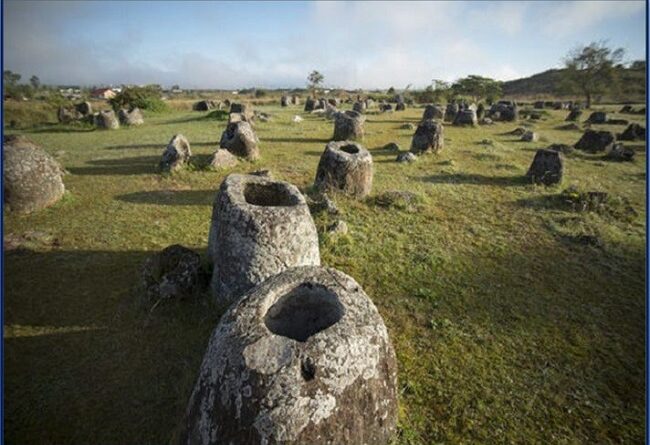‘The Plain of Jars, Laos’: scenery which you often see in your computer, take an exciting tour to the site.
The Plain of Jars in central Laos is one of Southeast Asia’s most mysterious and misunderstood prehistoric places. Around 90 sites scattered across miles of rolling landscape and contain thousands of giant stone jars, each stone weighing several tons. The stone jars surrounded by impressive scenery and offer easy access to an abundance of cultural and historic sites.

The Stone jars spread around the upland valleys and the lower foothills of the central plain of the Xiangkhoang Plateau. The Xieng Khouang Plateau is located at the northern end of the Annamese Cordillera, the principal mountain range of Indo-china.
A mystery about the Jars
To date, the origin of the jars is unknown, it is a wonder to see, how did they get there and why? Many researchers have theorized that the jars may have once served as funerals urns or food storage. Some believe that the jars collected monsoon rainwater for caravan travelers to use during the dry season. Travelers would use the water and then leave behind prayer beads or offerings in the jars.
in Xieng Khouang plains, Clusters of one to four hundred megalithic stone jars can be found throughout the province and archaeologists believe that they were originally used between 1,500 and 2,000 years ago.

Many local Laotian legends saying that the jars were created by Khun Cheung, an ancient king who lived in the highlands. It is said that Cheung, after fighting a victorious battle, created the jars in order to brew huge amounts of celebratory Lao Lao rice wine.
The majority of the jars are sandstone and have been manufactured with a degree of knowledge of what materials and techniques were suitable. It is assumed that Plain of Jars’ people used iron chisels to manufacture the jars although no conclusive evidence has been found.
Xieng Khouang Plain of Jars-
The Plain of Jars received Western attention in the 1930s when French archaeologist Madeleine Colani began surveying the area. Colani discovered a nearby cave housing human remains, such as burned bones and ash, leading her to believe that the jars were funeral urns for chieftains. Colani excavated the artifacts, some of which dated to between 500 BC and 800 AD, and published her findings in The Megaliths of Upper Laos.

Though the Xieng Khouang plain remains the central site of the jars, similar clusters can be connected to form a linear path all the way to northern India. The existence of similar jar clusters in other parts of Asia also led to the belief that the jars were part of a large trade route.
Also read- The Faroe Islands: A place like no other on earth, Volcanic islands with scattered basaltic terrain..’ everything is unbelievable’!
Till now over 100 jar sites have been found in the province of Phonsavan. Surprisingly, A vast area of Xieng Khouang’s plain covered with Jars (largest jars 2.5 x 2.57 meters).

Apart from this, the area remains one of the most dangerous archaeological sites in the world. Thousands of unexploded bombs remain from the Secret War of the 1960s, and some of these bombs still cause injuries to this day. Some Quarry is open to visitors, while a number of organizations work to remove explosives from the area.
The small town of Phonsavan is the capital of Xieng Khouang province and is the usual base for visiting the Plain of Jars.
Source-atlas Obscura, lonely planet



